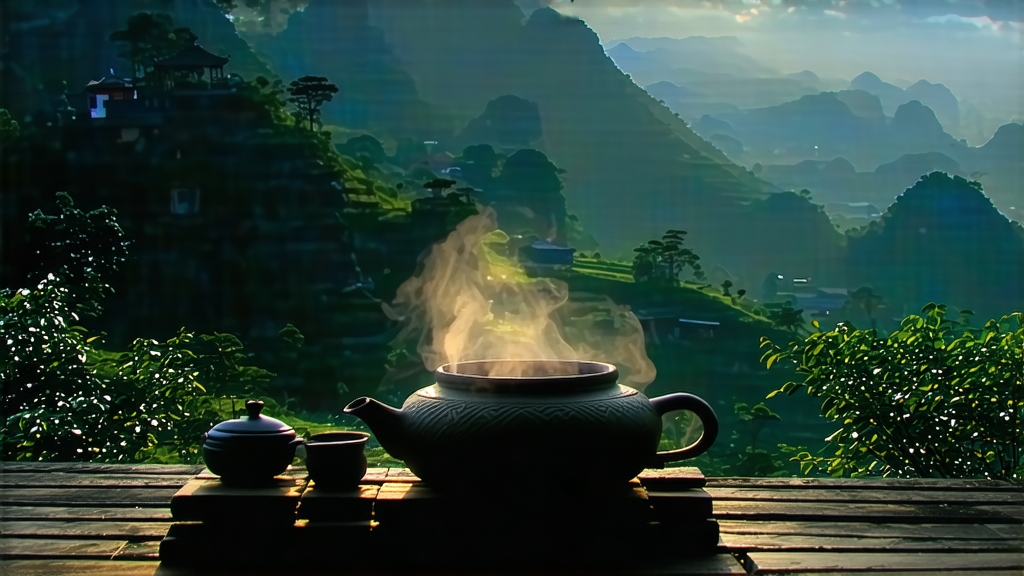
Tucked away in the humid mountains of southern China’s Guangxi Zhuang Autonomous Region, Liu Bao tea has spent four centuries quietly fermenting its way into the hearts of Cantonese merchants, Southeast Asian dockworkers and, more recently, global tea aficionados. Often overshadowed by its Yunnan cousin Pu-er, Liu Bao is the hidden archetype of Chinese dark tea: a leaf that travels well, ages gracefully, and carries the scent of damp earth, rainforest bark and a whisper of smoky betel nut. To understand Liu Bao is to taste the history of the ancient Tea-Horse Road’s southern spur, to feel the rhythm of bamboo baskets swaying on coolies’ shoulders, and to witness the alchemy of microbes turning green into black without fire.
Historical Footprints
The earliest written record appears in the 1661 county annals of Cangwu, describing “black cakes from Liu Bao village, bartered for salt along the Xi River.” By the Qing dynasty the tea had become a tax commodity, pressed into coarse bricks and shipped down the Xunjiang and Pearl Rivers to Guangzhou’s Thirteen Factories, where it was reloaded onto junks bound for Malacca, Penang and Singapore. Dock coolies prized the tea for dissolving grease from their fish-laden diets; Peranakan housewives steeped it with rock sugar to ease morning sickness. During the 1950s Guangxi Tea Import & Export Corporation standardized the name “Liu Bao” (literally “six forts,” referring to the original producing villages) and began exporting it via Hong Kong to reach dim-sum halls across the Pacific. Today Liu Bao is experiencing a renaissance: boutique producers age it in lava-rock caves, and collectors bid on 1970s “Zhong Cha” bricks at Kuala Lumpur auctions.
Micro-Terroirs within Guangxi
Although the protected geographical indication covers the entire Wuzhou prefecture, connoisseurs recognize three micro-zones. The first, Liudong, sits at 300–500 m on red lateritic soil; its tea yields a bright crimson liquor and a sweet, taro-like finish. The second, Yingtang, lies in a fog-shrouded valley where wild mandarin ducks outnumber humans; leaves grown here carry a pronounced camphor note thanks to the surrounding Cinnamomum trees. The third, Tashan, is a granite ridge whose mineral runoff imparts a flinty edge reminiscent of a Burgundy Pinot. Within each zone farmers further differentiate “shanjiao” (mountain-foot) and “shanya” (mountain-ridge) gardens, the former producing broader leaves suitable for long aging, the latter smaller leaves that ferment faster.
From Leaf to Dark Brick
Liu Bao’s processing follows a 150-year-old protocol known locally as “shuang zhong fa,” the double-fermentation method. Picking begins in late April when the standard is one bud with the third or fourth leaf, ensuring high lignin content for microbial digestion. After a brief outdoor withering, leaves are fixed in a 200 °C drum roaster for exactly 90 seconds—long enough to kill oxidative enzymes yet short enough to preserve leaf integrity. The critical step is “wet piling” (wo dui): 200 kg batches are sprayed with mountain spring water, covered by hemp canvas and left in a cedar-lined room for 35–45 days. Indigenous microbes—primarily Aspergillus niger, Blastobotrys adeninivorans and a Guangxi-specific strain of Bacillus subtilis—break down cellulose into soluble sugars while demethylating catechins into theaflavins that give Liu Bao its hallmark ruby colour. Unlike Pu-er’s shorter 25-day wo dui, Liu Bao’s longer pile allows a secondary yeast bloom that creates the tea’s signature betel-nut aroma. After piling, leaves are steamed, pressed into 500 g bamboo baskets or 1 kg brick molds, and transferred to “cool caves,” naturally ventilated lava tunnels that maintain 24 °C and 80 % humidity year-round. Here the tea enters a slow post-fermentation phase; enzymes continue nibbling at polyphenols while trace geosmin from cave walls adds a wet-stone nuance. A decade of cave aging is considered the threshold for “chen xiang” (aged fragrance), but some collectors keep Liu Bao for half a century, during which time the brick turns obsidian-black and the liquor acquires a medicinal sweetness likened to ginseng honey.
Decoding the Grade Codes
State-owned